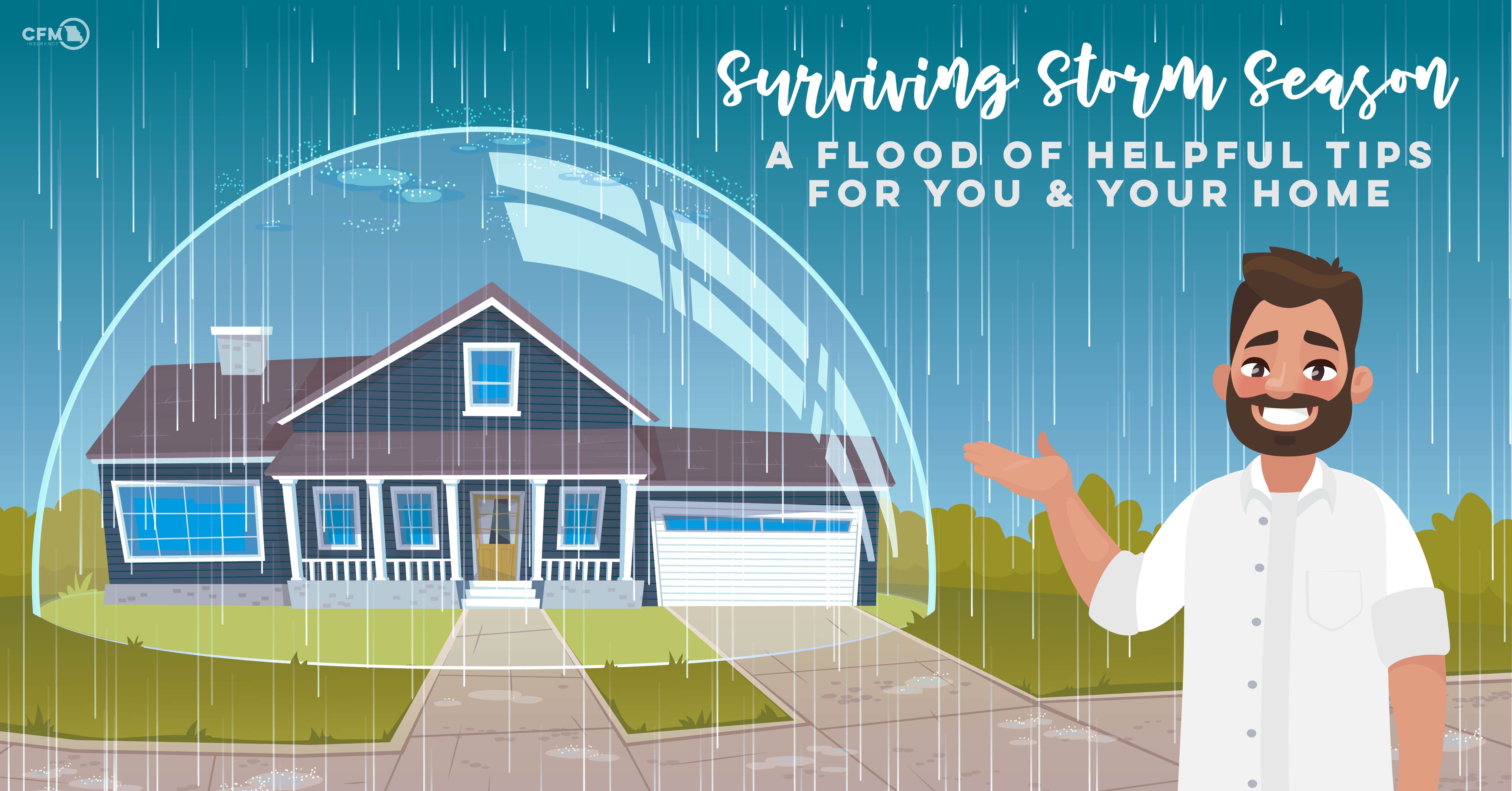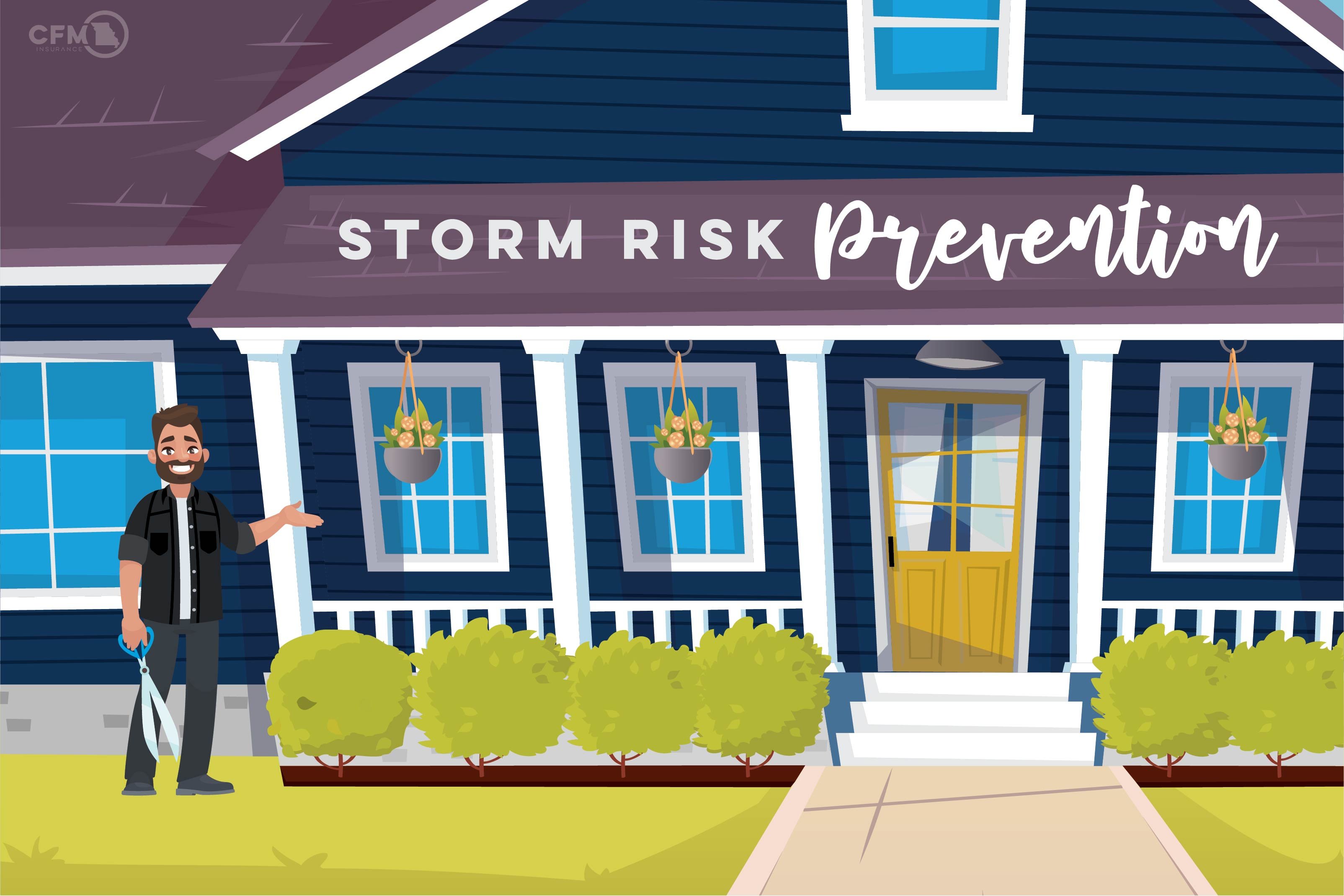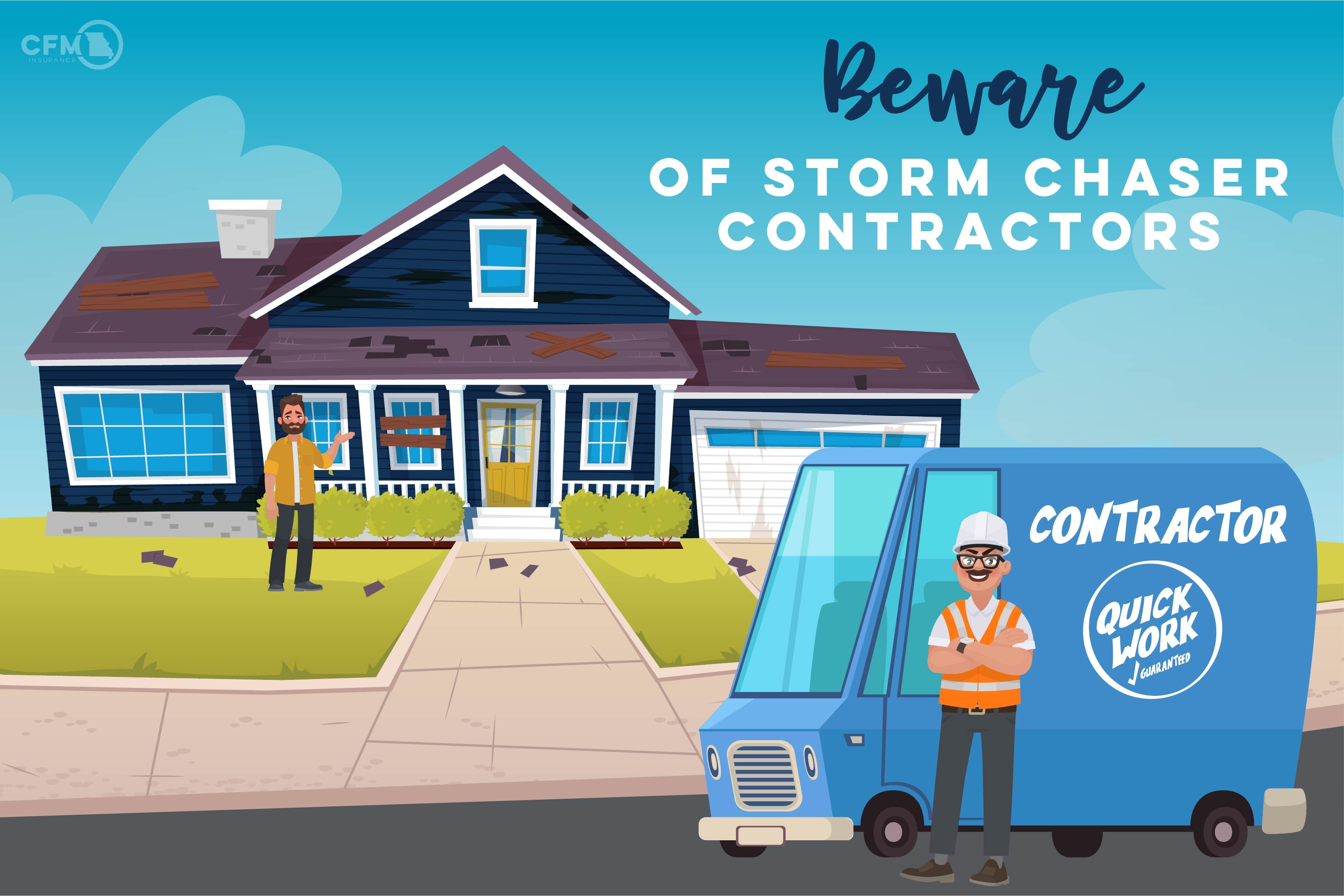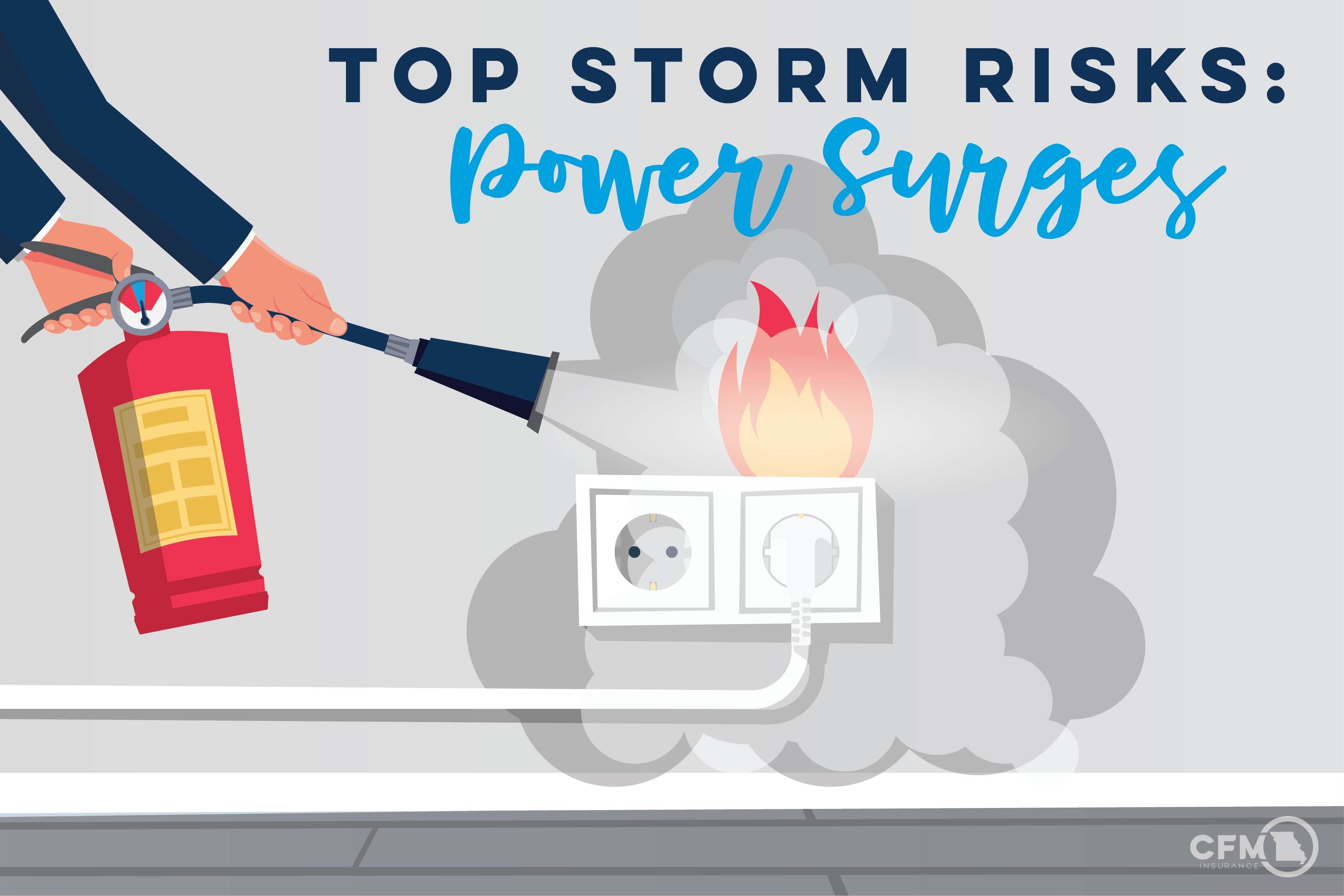
Ah, Spring: You bring us warmer weather (at least in the afternoon hours), pretty flowers, and green grass - a welcome sight after enduring months of drab scenery and freezing temperatures. While it's no secret that spring can be a beautiful thing about 80% of the time, the remainder is often spent enduring some of the year's most damaging storms. Remember the spring storm season a few years back that brought unimaginable devastation to our state? There was the violent EF-3 tornado that ripped through our state's capital on top of constant torrential rainfall that caused our riverbanks and surrounding rural towns to go completely underwater.
As Midwest natives, we know by now that the Show-Me-State is no stranger to sporadic, volatile storm patterns. Therefore, as property owners in a very bipolar-weather state, the only way to cope with the inevitable each year is to prepare for the worst and hope for the best.
Before jumping into our list of the best precautionary measures to help you and your property survive storm season, let's quickly look at what a typical Midwest storm season can involve. Plus, we'll assess the risks that follow as a result. You know, for those new to the MO scene.
The Most Common Storms In Our Region
 Wind & Hail Storms
Wind & Hail Storms
Strong winds are almost always expected with any severe storm. But, hail, that sneaky, most damaging ingredient to any stormy recipe aside from tornadic activity, can certainly make a lasting impression on your home too. On average, Missourians experience hail storms 2-3 times a year, according to the Missouri Climate Center. Most of the time, it is smaller than a pea (1/4") and will cause little or no damage. However, every once in a while, the hail can be more significant in size. The National Weather Service considers a thunderstorm severe if hail is 1-inch in diameter (quarter size) or larger. The maximum diameter a hailstone can grow is about 4.5 inches, comparable to the size of a softball. These larger hailstones can fall at speeds greater than 100 mph, leaving an obvious path of cosmetic destruction behind on our homes and cars below.
Severe Thunderstorms
Some of the most severe thunderstorms occur when a single thunderstorm affects one location for an extended time. Warm, humid conditions which start to ramp up in May are highly favorable for thunderstorm development. And where there's thunder, there is - of course - lightning. According to a study completed by The Weather Channel, Missouri is ranked in the top 10 states with the most lightning fatalities over the past 15 years. So, if you've ever heard the saying "If thunder roars, go indoors," be sure to follow it religiously. Meteorologists warn that you should stay indoors until 30 minutes after you hear the last clap of thunder.
Tornadoes
The state of Missouri is located in Tornado Alley, a catchy nickname for the geographical area in the USA that sees the most tornadic activity every year. This region also includes our friends in Texas, Oklahoma, Kansas, Colorado, Nebraska, South Dakota, North Dakota, Minnesota, and Iowa.
Did you know? Missouri accounts for 6 of the 25 deadliest tornadoes in U.S. history.
- Joplin – May 22, 2011
- St. Louis – Sept. 29, 1927
- Poplar Bluff – May 9, 1927
- Tri-State Tornado – March 18, 1925
- St. Louis – May 27 1896
- Marshfield – April 18, 1880
Torrential Rainfall, Followed By Flooding
Floods are the number one most frequently occurring natural disaster in the United States, and the most costly, according to the Federal Emergency Management Agency (FEMA). Because the two largest rivers in the country (Missouri and Mississippi Rivers) call MO home, our state tends to see recurring flooding patterns in the spring and summer months. That flooding only intensifies when induced by excessive snowmelt from a rough winter. Add in the rainy spring months of April and May each year, and you've got an unwanted combo of rainfall and flooding all at once: call it the perfect storm. That's why having an Inland Flood policy through CFM can be extremely helpful in combating any home damage caused by torrential rains and/or flooding. But, we'll talk more about that a little bit later.
Top Risks Associated With These Types Of Storms & Prevention Measures You Can Take

Structure Damage - Roof, Siding, & Gutters
When storms blow through your neighborhood, they take aim at homes with weak shingles, loose siding, and unsecured gutters. It only takes a little bit of wind to start the damage, followed by heavy rain or hail to finish the job. So, what can you do to make sure your home's exterior weathers the storm?
Outside
1. Schedule a routine inspection of your roof, siding, and gutters every spring...yes, every spring.
As a homeowner, you know the importance of regularly keeping up with your property to prevent any unwanted (and expensive) surprises from popping up. But it's certainly not your job to know how to inspect and identify issues with your siding, roof, and gutters. It would be best if you left that job to a local, licensed professional in your area. So, at the beginning of every spring, call a trusted home maintenance company to come and inspect your structure. That way, you can determine whether or not your roof, siding, or gutters need a little TLC before storm season comes around and creates a significant problem from a once small concern.

Important: Beware of Storm Chasers. Storm chasers - also known as storm gypsies - are out-of-town roofing contractors who travel around the country following the paths of storms. Their goal? To target vulnerable homeowners they can easily exploit. These deceiving contractors promise helpless homeowners quick, cheap repair work. They'll even throw in the added promise of influencing insurance companies to pay out the future claim no matter what. To avoid being left high and dry by a fraudulent company who installed a poorly constructed roof over your head, remember:
- Do your research on the web and social media to find only the most reputable roofing contractors from your area.
- Approach the contractor on your own and ask them for references. If the contractor approaches you first via door knocking or phone calls, be suspicious.
- Always call your insurance company and take the advice of your adjuster handling your roof claim. Claim adjusters handle so many claims throughout the year in your specific area. Therefore, they have a good knowledge of who to work with and who to avoid.
2. Reinforce your garage door.
When winds are strong enough, they can completely blow off even the most sturdy garage door and consequently damage the contents inside your garage. Take time every year or two to have your garage door professionally inspected before storm season's arrival, that way you know for sure it has the ability to withstand strong winds. For DIY tips on how to reinforce your garage door, check out this how-to video from Today's Homeowner.
3. Consider adding shutters to your windows and doors.
If you live in an area prone to damaging winds every storm season, take a note from coast dwellers and consider installing steel or aluminum storm shutters on your windows, French doors, and sliding glass doors for added protection. If they can keep glass safe from hurricane force winds, they're probably a good match for a Midwest storm. When you hear that a storm is coming, you can quickly close the shutters to prevent flying debris from breaking glass - saving you a mess and costly repairs.
4. Clean your gutters regularly.
It's imperative to keep your gutters clear of debris all year round, but especially during storm season. If you're not comfortable climbing up and looking around in your gutters, hire a professional to do it seasonally. Otherwise, your home - and you - will pay the price. Having your gutters cleaned regularly can:
- Prevent water damage. When gutters and downspouts become blocked by leaves and debris, rainwater can't drain properly. As water overflows from gutters, it can cause water damage on both the interior and exterior of your home.
- Protect your roof. Because clogged gutters give rainwater nowhere to run, excess water will continually flood over and leave a rotten or leaky roof.
- Keep pests from causing problems. Gutters overrun with leaves make for a desirable nest for rodents, birds, and insects. The last thing you want is a pest infestation in your home because homeowners insurance doesn't cover damage caused by vermin.
- Reduce the risk of a cracked foundation. When water can't safely travel away from your home, it can pool around the foundation of your property. This resting water can then crack your foundation when it expands and freezes in the winter months.
5. Keep up with your landscaping.

You wouldn't think landscaping has anything to do with storm damage prevention, but it certainly does. When you don't address dead trees positioned close to your home, the weak limbs or entire shell of the tree can be blown onto your roof or car with minimal effort. Consult with a licensed and insured landscaping company about removing any dead limbs or overgrown live trees to keep the potential of one falling on your home low.
It's also smart to move any over-sized rocks, bricks, or pavers away from your home. Instead, opt for mulch, as its light weight will fare much better in high speed winds. Large, decorative rocks, for example, can cause damage to windows, railing, and siding to name a few, if strong enough winds pick them up (and unapologetically relocate them). For some help creating a storm-friendly landscape, check out this design app for homeowners.
6. Properly secure all outdoor furniture.
Much like how tree limbs can be blown around in a storm, so can your patio set, trampoline, and barbecue grill. Keeping them properly anchored to the surface they rest on can prevent this from happening during the spring and summer months. Use these methods:
- Stake your furniture to the ground using anchors or use bolts to drill them in place on your decking.
- Use Earthquake Gel to bond glass tabletops to their base.
- Connect your furniture together with bungee cords and place them in a corner when a storm is about to hit.
- Plant wind barriers for future storm protection.
- Consider buying new furniture made of heavy materials like wrought iron, cast aluminum, or steel.
Inside
1. Keep your smartphone - equipped with weather alerts - nearby to stay prepared for even the smallest storm.
Having access to a reliable weather app at your fingertips is perhaps the most effective warning system for incoming severe storms. If you aren't a CFM Policyholder with Roost Weather Alerts through the CFM @ Home App, download one of the recommended weather apps below. And don't forget to turn up your notification settings on loud, that way, you'll know exactly when a storm is about to move into your zip code.
2. Keep an updated home inventory.

Nothing's worse than suffering a loss and not having a detailed list of what you need to be replaced in an insurance claim scenario. It not only helps you know what you'll need to recover but your claims adjuster too, as they'll want to make sure you have all of your belongings accounted for. Take time to go through your home and record everything you own, or at least the big-ticket items you'd be devastated to lose. Next to those items, list their estimated value and the year they were purchased. If you're old-fashioned and have a handwritten home inventory list, store it in a safe place. That way, you can easily access it and give it to your claims adjuster should your home suffer storm damage. If you're more into the tech scene, consider one of the home inventory apps below. And don't forget to update your inventory over the years as you accumulate more valuable personal property.
3. Build an emergency kit.
It's always good to have an emergency kit on hand before disaster strikes. Your kit should have these basics:
- First-aid supplies
- Flashlights/batteries
- Candles/matches
- AM/FM weather radio
- Water/non-perishable food items
- Work gloves and seasonally appropriate footwear (like rain boots for potential flooding incidents)
- Toiletries
- Special medication/formula (if you have a baby)
- Tools to turn off utilities
Make sure you show everyone in your family what is in the emergency kit and where it can be found. Everyone in your household needs to be on the same page about what the kit is used for and also how to use the items in it.
Water Damage & Mold Growth
It only takes one isolated heavy spring rain spell to cause massive water damage to your home. Because homeowners insurance is designed to provide coverage for sudden and accidental damage - not damage that is a result of lack of maintenance - be sure you're taking these steps to prevent storm-related water damage at your property the best you can.
1. Know how to shut off your water main.
If your pipes get damaged in a storm or flooding incident, they may become filled with contaminated water. To avoid this polluted water from entering your home, you'll need to shut off your home's water supply. This shut-off process is also simple:
- Locate your home's main water shut-off valve, which is typically located inside your home, in the basement, near the main water line. After you track down the valve, turn the handle or knob clockwise until the valve closes completely. Don't turn your water back on until you've been given the green light from city officials.
2. Inspect your sump pump in the basement.
Your sump pump is in charge of keeping groundwater from getting in your basement or crawlspace by moving excess water out and away from your home's foundation. If your sump pump stops working, it can cause water to creep into your home, leaving a mess for you - including potential mold and mildew growth. Test your sump pump before storm season starts to make sure your basement doesn't run the risk of flooding. You can do this by unplugging the pump and then plugging it in again or running water through it. For more details on how to check your sump pump, watch this live inspection from home inspector, Mark McCaffrey.
3. Consider purchasing an Inland Flood endorsement through CFM.
While there is flood insurance available to homeowners through the government-run National Flood Insurance Program (NFIP), it solely aims to cover high-risk areas that require flood insurance by law. For inland residents outside of these areas, coverage is "optional." But because of high limits, surcharges, and exclusions that come with that coverage, the enrollment rate is only 1% in low-to-moderate risk areas. This doesn't stop floods from hitting these areas; in fact, 20% of NFIP flood claims come from low-to-moderate risk areas, with an average claim of $27,000.

If you're an inland resident, you now have a more affordable coverage alternative to NFIP insurance. Designed specifically for residents in low-to-moderate risk areas, our CFM Inland Flood Coverage endorsement can add affordable flood coverage to existing Homeowner, Farmowner, Fire and Extended Coverage policies. This insurance covers the most common exposures residents face from an inland flood, including personal property, basement exposures, and appliances.
4. Place leak detecting sensors around your basement to spot potential in-home flooding.
The most efficient, easy way to monitor for potential water hazards due to excessive rainfall at your home is by utilizing leak detectors strategically placed around your home's interior. For example, our partner company, Roost, has a Smart Water Leak & Freeze Detector that provides early detection of common home problems like water leaks, abnormal humidity levels, and freezing pipes. This small but mighty wifi-enabled Roost device delivers critical benefits to homeowners by working in conjunction with the CFM @ Home app to detect small leaks before they become a huge (and expensive) headache. Simply place the devices around basement windows to catch abnormal water levels near your foundation before you wind up with a flooded basement.
Home Fire & Power Surge
 When a lightning storm strikes, power surges can occur and even spark a full-blown home fire in many cases. Take these simple measures into consideration to protect your home against both.
When a lightning storm strikes, power surges can occur and even spark a full-blown home fire in many cases. Take these simple measures into consideration to protect your home against both.
1. Make sure all major electronics and appliances are connected to surge protectors.
Lightning is the most common culprit of power surges for homeowners. When a power surge (large spike in electricity) happens, it causes a sudden current of excessive heat, which can burn a wire and anything connected to it. This can not only ruin your expensive appliances and electronics but also cause a structural fire. Investing in a surge protector will help protect your high-dollar items and home in the event of a lightning storm. The typical surge protector only costs around $40 - a bargain compared to the cost of that 72-inch T.V. sitting in your living room. If you're sold on the idea but don't know where to start, check out this list of the top-rated surge protectors from Tech Hive.
2. Know how to shut off the primary source of power and gas in your home.
Everyone knows knowledge is power, and the more you know about your home's working parts, the better. After a severe storm strikes, it can cause damaged electrical sockets or appliances to produce sparks. These sparks can then cause a fire if the power doesn't get shut off immediately. Luckily the shut-off process is pretty simple:
- Locate your home's breaker box and shut off the main breaker at the top of the electrical panel. Don't switch the circuit back on until you're sure there are no damaged electrical outlets in your home or live gas leaks. If you're concerned one of these two things has happened, leave your home and contact your local emergency response specialists immediately.
Important: Damaged gas lines after a storm can cause contamination of your air and potentially a fire. It never hurts to contact your local utility company and ask for instructions on how to turn off your home's gas line in the event of a disaster. You can then keep the instructions handy or put them near your gas meter, so you'll know exactly what to do if the time comes.
3. Install a smart battery into your CO/Smoke Detector.
Roost offers customers a Smart 9V Battery which transforms existing CO and smoke detectors into a smart alarm. When an alarm sounds, you will be notified instantly through the CFM @ Home app. So, if a lightning storm strikes while you're away from home, causing a fire, you'll be alerted right away, thanks to Roost. That way, the home fire can be addressed immediately instead of escalating into a total loss situation.
If Storms End Up Damaging Your Property, File A Claim Quickly & Easily Through The CFM Policyholder App
 Filing an insurance claim is easy with the CFM Policyholder App. Sometimes despite our best efforts to prevent an insurance claim from happening by using the prevention techniques mentioned above, certain circumstances leave you no choice but to file one. After all, that’s what your insurance is for - to be there for you when you really need it. At CFM, our goal is to make your claims process as stress-free and simplified as possible. So, we’re now offering you the convenience of reporting a claim on your phone through the Policyholder App. We’ve created a streamlined five-step claims process at your fingertips, allowing you to upload claims photos, check on status updates, and contact your adjuster easily. Click here for a breakdown of how the app works and where you can download it.
Filing an insurance claim is easy with the CFM Policyholder App. Sometimes despite our best efforts to prevent an insurance claim from happening by using the prevention techniques mentioned above, certain circumstances leave you no choice but to file one. After all, that’s what your insurance is for - to be there for you when you really need it. At CFM, our goal is to make your claims process as stress-free and simplified as possible. So, we’re now offering you the convenience of reporting a claim on your phone through the Policyholder App. We’ve created a streamlined five-step claims process at your fingertips, allowing you to upload claims photos, check on status updates, and contact your adjuster easily. Click here for a breakdown of how the app works and where you can download it.
While the weather will always be unpredictable, you can confidently stay ahead of storm season by implementing all the easy, practical tips above. Don't forget - it never hurts to review your insurance policy with your agent before every storm season to make sure you have all the coverage you want and need for your home and belongings. This will prevent you from being blindsided down the road if a loss occurs, which is something we never want for our policyholders. Track down your local CFM Agent by clicking the image below



Your Comments :